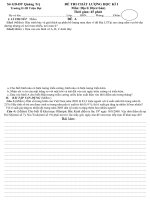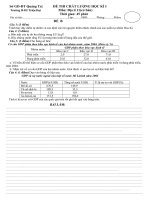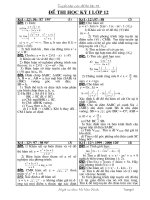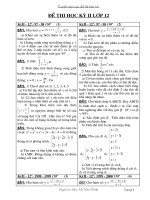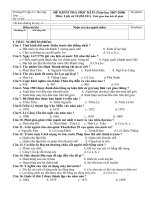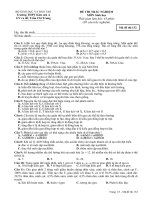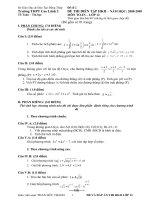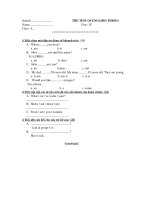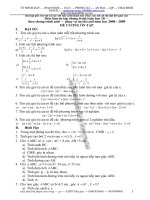ĐỀ THI CUỐI KÌ LƠP 12 ban cơ bản
Bạn đang xem bản rút gọn của tài liệu. Xem và tải ngay bản đầy đủ của tài liệu tại đây (65.75 KB, 4 trang )
I. Read the following statements and decide whether each statement is true (T) or false ( F)
Statements T F
1. When designers put syllabus together, they have to consider these following criteria
including Learnability, Frequency, Coverage and Usefulness.
2. The grammar syllabus is the most popular syllabus from past to now.
3. The choice of teaching methods primarily depends on learners’ abilities.
4. Learnability, Frequency, Coverage and Usefulness helps syllabus designers differentiate the
types of syllabuses.
5. Coursebook can serve as a syllabus.
6. Coursebook can possibly supply satisfactorily the learning needs of every learner.
7. Lesson plan is the detailed plan of the lesson with its content, activities, teaching aids, and
time distribution for a particular group of learners, prepared by the teacher before his actual
teaching.
8. Varied activities provided in random order can result in a feeling of restlessness and
disorder.
9. The functional syllabus aims for communicative function and make use of daily life
language.
10. Four main planning elements of a lesson plan include Activities, Language skills,
Language type and Subject & Content.
11. Summative assessment encompasses of many of the ordinary learning tasks students do
on a routine basis.
12. Diagnostic tests are used to put students into groups or classes relevant to their language
level.
13. Testers select the test items and task before analyzing the test items and task.
14. Teachers use Bloom’s taxonomy to determine and specify the level of competency that
learners want to attain.
15. Reliability is used to classify stronger students and weaker students.
II. Fill in the each gap with the most suitable words (no more than 3 words for each gap)
1. Some structural or lexical items are easier for students to learn than others. Therefore, some
teachers often teach easier things first, and then increase the level of………as the students’
language level rises.
2. A ..............syllabus offers the possibility of selecting and sequencing different real- life situation
rather than different grammatical items, vocabulary topics or functions.
3. In practice, multi-syllabus takes a………………as a starting point.
4. One solution to the disadvantages of coursebooks is to do without them together, to use a
……….approach.
5. A good test should give………….results. For example, if the same group of students took
two similar tests in different time, they should get the similar making range.
6. Writing the………..of a lesson involves the use of Bloom Taxonomy.
7. The lesson can be graded into essential, related and……information.
8. The two overriding principles of a good lesson planning are variety and ……..
9. Good lesson planning is the art of mixing techniques,……, and materials in such a way that an
ideal balance is created for the class.
10. A……….objective of the lesson plan gives learners and instructors an overall idea of what
the learners are expected to achieve at the end of the instruction.
11. ………tests can be used to expose learners difficulties, gaps in their knowledge, skill
deficiencies during a course
12. A test item is direct if it asks candidates to perform the………skill which is being tested.
13. Multiple choice questions are often used to measuring students’ knowledge
of…….and………
14. If the instructions of a test are unclear and the test format is unfamiliar, the students’
response may not reflect their true ability, then the test may be said to lack……………….
15. Testing is one way to…….student’s performances
III. Choose the best answer by circling the letter A, B, C or D.
1. Which of the following is not true about a syllabus?
A. Syllabus’s function is simply “to specify what is to be taught and in what order”.
B. Syllabus is a curriculum.
C. Syllabus is to guide for both the teacher and students by providing some goals to be accepted.
D. Syllabus is the selection of items to be learnt and the grading of those items into an appropriate
sequence.
2. The teacher tends to teach her students the easier things first and then increases the levels of
difficulties. Which criteria is mentioned above to design a syllabus?
A. Learnability B. Frequency C. Coverage D. Usefulness
3. Which kind of syllabus is it when the teacher provides her students useful expressions to show
agreements or disagreements?
A. Grammar B. Lexical C. Functional D. Situational
4. When choosing a coursebook, the teacher has to consider and decide whether certain activities are
suitable for her students or not. This issue is related to the …….. of a coursebook?
A. Coverage B. Text C. Tasks D. Administration
5. When using a coursebook, if the teacher wants to fulfill her aims and gain a successful lesson, she
will have to adapt materials such as………… a textbook activity with another more suitable.
A. Change B. Remove C. Replace D. Add
6. In the stage of Pre-planning a lesson, the teacher has to decide what to be taught to provoke her
students’ interest and involvement. Which element is it in lesson planning?
A. Activities B. Skills C. Language D. Content.
7. A detailed lesson plan mainly contains its content, activities, teaching aids and……..
A. time-distribution B. reflection C.games D. interactions
8. In a formal lesson plan, this part is to reflect what the teacher expects her students to acquire after
the lesson. Which part is it?
A. Class description B. Problem Anticipations C. Lesson Aims D. Interactions
9. According to Bloom’s taxonomy, which level of intellectual behaviors is it when the teacher asks her
students to write the correct form of the verbs in brackets?
A. Analysis B. Knowledge C. Comprehension D. Application
10. What is not true about Testing?
A. It is an instrument to compare students’ performance and teacher’s aims with specified criteria.
B. It is used to indicate how well or badly the students have performed.
C. It is a helpful tool among procedures and tasks designed to assess the students
D. It is mostly used for assessment.
11. Using “student response” is one of the ways for……………..
A. coursebook adaptation B. coursebook choice C. Evaluation measure D. coursebook use
12. The test is what students and parents want and it looks familiar with them. Which validity is it?
A. Content validity B. Statistical validity C. Response validity D. Face validity
13. The test is given at the end of the course and aims to measure how successful each student has
been after finishing the course. Which type of test is it?
A. Achievement B. Prognostic C. Proficiency D. Placement.
14. The test focuses on Speaking skill. Which test item is not one of the subjective methods?
A. Role plays B. Sentence repetition C. Describing pictures D. Information gap activities
15. If the teacher wants to check the students’ reading skill, she should use………as the best activity.
A. Interview B. Error correction C. True/false/does not say D. Picture ordering
Answer keys:
I. 1T 2T 3F 4F 5T 6F 7T 8T 9T 10T 11F 12T 13F 14F 15T
II.
1. difficulty
2. situational
3. grammar syllabus
4. “do it yourself”
5. consistent
6. objectives
7. complementary
8. flexibility
9. activities
10. general
11. diagnostic
12. communicative
13. grammar/ vocabulary
14. validity
15. assess
III.
1 b 2 a 3 c 4 c 5 c 6 d 7a 8 c 9 d 10 b 11 c 2 d 13 a 14 b 15 c
